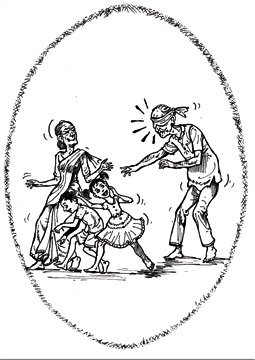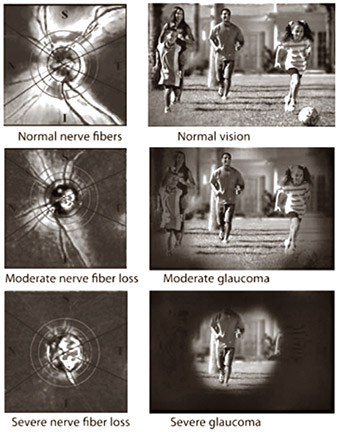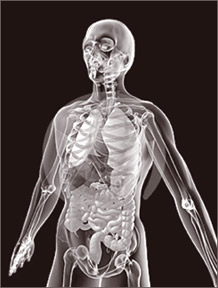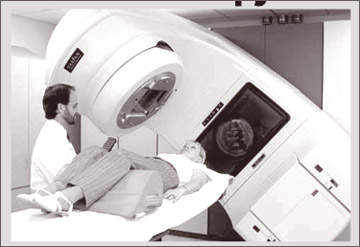|

Glaucoma - easily preventable:
Early detection will save your eyes
By Nilma DOLE
 Imagine
not being able to see your grandchildren when they play, not being able
to see your younger daughter's wedding or not being able to cross the
street without help. Our vision is something that we take for granted so
if we ever lose it, we realise the value of it. This is why we need to
check our eyes at least twice a year to see if we have problems with our
vision. No matter how old or young you are, complications can occur at
any age or due to any cause. Therefore it is imperative that you check
your eyes. Imagine
not being able to see your grandchildren when they play, not being able
to see your younger daughter's wedding or not being able to cross the
street without help. Our vision is something that we take for granted so
if we ever lose it, we realise the value of it. This is why we need to
check our eyes at least twice a year to see if we have problems with our
vision. No matter how old or young you are, complications can occur at
any age or due to any cause. Therefore it is imperative that you check
your eyes.
Glaucoma is an easily preventable condition where once you detect it
early or else the consequences are tragic if you don't detect it early.
It is very important for any person over the age of 40 years to check
their eyes because it would mean either losing or keeping your vision.
Around the world, blindness is caused by cataract, Age-Related
Macular Degeneration (ARMD), Diabetic Retinopathy and Glaucoma.
Statistics
Dr. P.G. Maheepala, Additional Secretary at the Health Ministry said,
"Estimated statistics reveal that 285 million people are visually
impaired and out of this number, 39 million people are totally blind."
He said that the important thing is that when talking about the 39
million, 90 percent of blindness are prevalent in poor communities in
the world where 60 percent is treatable and 20 percent is preventable.
He said, "Of the six WHO (World Health Organisation) world regions,
South East Asia and Western Pacific account for 73 percent of moderate
to severe visual impairment and 58 percent of blindness."
Global blindness is increasing by 1 to 2 million every year which
highlights the recent trend towards a decline in infectious diseases,
while chronic non-communicable diseases, which affects both the
developed and the developing world, are rising steeply.
"At present, we estimate that 150, 000 people in Sri Lanka are blind
and out of this number, 18, 000 people are blind due to refractive
errors. About 57, 000 have cataract, 10, 500 have macular degeneration,
6,000 have diabetic retinopathy and 15, 000 suffer from glaucoma," said
Dr. Maheepala. He said that there are 400, 000 people in Sri Lanka who
have low vision in some way that need some kind of rectification.
 The Sri Lankan situation has challenges but the Ministry of Health
together with support from the Agency for the Prevention of Blindness (IAPB)
have developed a plan to combat blindness with the Vision 2020 'Right to
Sight' program. The Sri Lankan situation has challenges but the Ministry of Health
together with support from the Agency for the Prevention of Blindness (IAPB)
have developed a plan to combat blindness with the Vision 2020 'Right to
Sight' program.
"Breadwinners who lose their sight are seen as burdens not only to
society to family so prevention is important, but if problems occur,
prompt treatment, therapy and family support is needed," said the
doctor. In many parts of the world, blindness adds to individual, family
and community poverty. "Effective interventions are available that can
prevent or cure 80 percent of blindness and these interventions are not
expensive," he said.
Dr. Maheepala said, "With the assistance of our stakeholders, we aim
to reduce avoidable blindness in Sri Lanka through the development of a
sustainable and equitable national programme for prevention and control
of blindness as a part of national health system."
Making the program a success will save 15, 000 people from blindness
which is a US$ 25 million savings in lost productivity.
The present situation with regard to the Vision 2020 program is that
there are 14 clinics situated island-wide to help detect and combat
low-vision. "Free cataract surgeries have been done, 4,000 custom-made
spectacles have been given for poor families, eight clinics have been
set up to deal with Diabetic retinopathy, seven eye units and 40 mobile
clinics have been set up, primary eye care units in main hospitals have
been established and three national programs have been started in the
Western, Sabaragamuwa, North Central and Southern provinces.
Consultant eye surgeon, National Eye Hospital, Dr. Muditha Kulathunga
explained that glaucoma occurs when the aqueous solution in the eye
builds eye pressure and this condition affects the optic nerves.
Glaucoma is a disease where the optic nerve is damaged, leading to a
gradual and irreversible loss of vision which is often, but not always,
associated with increased pressure of the fluid in the eye.
"Usually the aqueous liquid in the eyes evaporate naturally to
balance and equalise the pressure in the eye but if it doesn't happen,
solution is accumulated causing glaucoma," she said.
According to the doctor, there are two conditions of glaucoma, namely
acute angle closure and open angle glaucoma. These can occur as primary,
secondary or congenital glaucoma which can trigger blindness. Closed
angle glaucoma can affect suddenly and is often painful loss of vision
leading the patient to channel an eye doctor immediately before
permanent damage occurs. Open angle, chronic glaucoma tends to progress
more slowly and the patient may not notice that they have lost vision
until the disease has progressed significantly.
In rare cases, glaucoma can be hereditary and those who have family
members stricken with glaucoma should at least get their eyes checked.
Patients will sometimes notice gradual loss of peripheral vision and
they can develop problems in their photographic eyesight. Sometimes,
they will feel as though they can't handle seeing bright light and their
cornea becomes white (corneal opacity) said the doctor. Symptoms of
angle closure glaucoma includes pain in or around the eye ball, redness,
headache, nausea or vomiting and visual disturbances, for example halos
around lights and in some cases there are no symptoms.
Vision
"If untreated, there is a gradual progression of optic nerve damage,
gradual loss of vision leading to total Blindness," said the doctor.
Treatment is usually lifelong but it helps maintain and sustain vision.
"There are Beta blockers, miotics, adrenergic agonists, Carbonic
anhydrase inhibitors and prostaglandin analogues which can help treat
glaucoma," said Dr. Kulathunga.
There is surgical treatment available in the form of YAG laser
peripheral iridotomy, Argon laser trabeculoplasty, trabeculectomy, Deep
sclerectomy, Filtration procedures, Tube-shunt procedure and
Cyclophotocoagulation. Regular follow-up should be done and surgeries
require after-surgery therapy and counselling.
Anyone diagnosed to have glaucoma has to continue the medication
given by the doctor.
According to the doctor, medication shouldn't be stopped and should
be taken as prescribed by the doctor to sustain vision. "Patients tend
to stop using the medication if they don't see a vision improvement but
they must realise that treatment preserves and keeps whatever vision
they have. If they don't heed doctor's advice, they most certainly will
lose their vision," she said.
However, the story in Jaffna seems to be different as even though the
Jaffna Teaching hospital is fully-equipped with the latest eye equipment
and technologies, there is another problem. Dr. Chandrakumar of the
Jaffna Teaching Hospital, the first eye surgeon to be appointed at the
Jaffna Teaching Hospital said, "There seems to be a genetic eye disorder
that has been surfacing.
We are still researching on this condition and will know soon whether
it is deadly or not," he said.
The good news is that more than any hospital in Sri Lanka, the Jaffna
Teaching Hospital has all the facilities to combat blindness which is an
integral part of the Vision 2020 program.
The poor exploited by growing market for human organs
A Michigan State University anthropologist who spent more than a year
infiltrating the black market for human kidneys has published the first
in-depth study describing the often horrific experiences of poor people
who were victims of organ trafficking.
 Monir Moniruzzaman interviewed 33 kidney sellers in his native
Bangladesh and found they typically didn't get the money they were
promised and were plagued with serious health problems that prevented
them from working. Monir Moniruzzaman interviewed 33 kidney sellers in his native
Bangladesh and found they typically didn't get the money they were
promised and were plagued with serious health problems that prevented
them from working.
The study, which appears in *Medical Anthropology Quarterly*, and
Moniruzzaman's decade-long research in the field describe a growing
worldwide market for body parts that include kidneys, parts of livers
and even corneas. Moniruzzaman said the people selling their organs are
exploited by unethical brokers and recipients who are often
Bangladeshi-born foreign nationals living in places such as the United
States, Europe and the Middle East. Because organ-selling is illegal,
the brokers forge documents indicating the recipient and seller are
related and claim the act is a family donation.
Doctors, hospital officials and drug companies turn a blind eye to
the illicit act because they profit along with the broker and, of
course, the recipient, said Moniruzzaman, who questioned many of the
people involved. Most of the 33 Bangladeshi sellers in his study had a
kidney removed across the border in India. Generally, the poor seller
and the wealthy recipient met at a medical facility and the transplant
was performed at that time, he said.
"This is a serious form of exploitation of impoverished people, whose
bodily organs become market commodities to prolong the lives of the
wealthy few," said Moniruzzaman, assistant professor in the Department
of Anthropology and the Center for Ethics and Humanities in the Life
Sciences. Moniruzzaman recently delivered his research findings and
recommendations on human organ trafficking to both the Tom Lantos Human
Rights Commission of the U.S. Congress and the U.S. Senate Committee on
Foreign Relations.
His briefing included the experiences of Mehedi Hasan, a 23-year-old
rickshaw puller who sold part of his liver to a wealthy recipient in the
Bangladesh capital of Dhaka. Like many poor Third World residents, Hasan
did not know what a liver was. The broker exploited this fact and told
Hasan the sale would make him rich.
The recipient died soon after the transplant. Hasan received only
part of the money he was promised and is now too sick to work, walk long
distances or even breathe properly. He thinks often of killing himself,
Moniruzzaman said.
Organ brokers typically snag the unwitting sellers through deceptive
advertisements. One ad, in a Bangladeshi newspaper, falsely promised to
reward a kidney seller with a visa to the United States. Moniruzzaman
collected more than 1,200 similar newspaper ads for the study. The organ
trade is thriving in Bangladesh, a country where 78 percent of residents
live on less than $2 a day. The average quoted price of a kidney is
100,000 taka ($1,400) - a figure that has gradually dropped due to an
abundant supply from the poor majority, Moniruzzaman said.
One Bangladeshi woman advertised to sell a cornea so she could feed
her family, saying she needed only one eye to see. That transplant
didn't happen, but Moniruzzaman said there have been cases of corneas
being sold.
Moniruzzaman said it's important to note that most sellers do not
make "autonomous choices" to sell their organs, but instead are
manipulated and coerced. He said the global trade of organs is a fairly
recent phenomenon - made possible by advances in medical technology in
the past 30 years - that represents a form of gross exploitation unseen
in human history.
To combat organ trafficking, he recommends, among other steps: -
Global governance. The U.S. Department of State should play an active
role in putting pressure on national affairs and foreign governments to
acknowledge the problem and insisting on crackdowns on brokers,
recipients, doctors and businesspeople involved in the trade.
- Transparency and accountability. The State Department should ensure
all medical centers have a transplantation registry and verify the
relationship between recipients and donors. - Cadaveric donation.
Countries such as Bangladesh that do not have a system in which people
can donate organs when they die should implement these systems. The
United States should provide aid and encourage cadaveric organ donation
through educational institutions, news media and religious centers.
Realistically, organ trafficking will never be eliminated,
Moniruzzaman told lawmakers on the Human Rights Commission.
"But with our collaborative efforts," he said, "we can significantly
reduce this gross violation of human rights."
- MNT
Improving the effectiveness of chemotherapy
Researchers from the University of Zurich have found a cellular brake
that protects cancer cells from chemotherapy - and they demonstrate
which medication can be used to render it inoperative. Their study
published in the journal Natural Structural and Molecular Biology
provides the molecular basis for promising therapeutic advances.
Although many cancer drugs have already been in use for decades, their
mode of action is still unknown. The new research results now challenge
a mechanism of action that was previously proposed for a group of drugs
and supported with experiments: the Topoisomerase I-inhibitor
Camptothecin (Top1 inhibitor for short) and its derivatives used in
chemotherapy, Topotecan and Irinotecan.
 Problem: emergency cellular brake restricts effectiveness Problem: emergency cellular brake restricts effectiveness
For a long time, the toxicity of the top1-inhibitors was attributed
to discontinuities in the cancer cells' DNA that inevitably caused
breaks in the chromosomes during the duplication of the DNA. The team
headed by Professor Massimo Lopes at the University of Zurich's
Institute of Molecular Cancer Research has now identified a mechanism
with which cancer cells protect themselves against damage caused by Top1
inhibitions: Using electron microscopy, the researchers were able to
demonstrate that Top1 inhibitors can cause the replication forks that
develop during the duplication of the DNA to be restructured. "Reversed"
replication forks, or "chicken-foot" structures as they are also known,
are formed. This remodeling of the replication forks provides the cancer
cells with the time they need to repair the lesion in the DNA and thus
prevent disparately cytotoxic chromosomal breakage.
"Until now, the assumed mechanism of action of Top1 inhibitors was
comparable to a train hurtling towards an obstacle without brakes that
inevitably ends up derailing," explains Massimo Lopes, commenting on the
results. "What we have now discovered is the emergency brake, which the
cells activate themselves to protect themselves from the inhibitor."
Arnab Ray-Chaudhuri, who made a considerable contribution to the study,
draws the following conclusion: "Thanks to the discovery of this
mechanism, we now understand why chemotherapy does not always work as
expected with these drugs."
The existence of such DNA structures was hypothesised many years ago,
but it has only just been confirmed in human cells by Lopes's group.
These chicken-foot structures are even surprisingly common with
clinically relevant doses of Top1 inhibitors.
Solution: render emergency brake inoperative
The new observations reveal an interesting coincidence: In pulling
the emergency brake, a family of enzymes that recently attracted a great
deal of interest as a potential target for new cancer therapies is
involved in the restructuring: the poly-ADP-ribose polymerases, or PARPS
for short. After all, PARP inhibitors increase the sensitivity of cancer
cells to different drugs that harm the DNA, including Top1 inhibitors.
The new study reveals why: PARP inhibition hinders the reversal of
the replication forks and increases the number of chromosomal breaks
caused by Top1 inhibitors.
Massimo Lopes and his team thus provide a clear molecular basis for
the clinical observations described and pave the way for promising
therapeutic advances.
Massimo Lopes's team is currently investigating whether the same or a
similar mechanism is activated by other classes of chemotherapeutics and
which cellular factors are involved in this molecular "emergency brake".
The aim is to identify tumors in which this mechanism is not active
or inhibit the mechanism pharmacologically to improve the efficacy of
chemotherapy.
- MNT |

